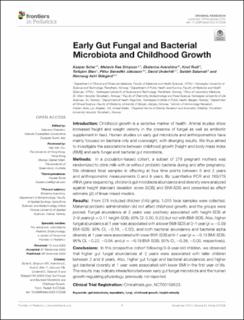| dc.contributor.author | Schei, Kasper | |
| dc.contributor.author | Simpson, Melanie Rae | |
| dc.contributor.author | Avershina, Ekaterina | |
| dc.contributor.author | Rudi, Knut | |
| dc.contributor.author | Øien, Torbjørn | |
| dc.contributor.author | Juliusson, Petur Benedikt | |
| dc.contributor.author | Underhill, David | |
| dc.contributor.author | Salamati, Saideh | |
| dc.contributor.author | Ødegård, Rønnaug | |
| dc.date.accessioned | 2021-05-14T08:10:01Z | |
| dc.date.available | 2021-05-14T08:10:01Z | |
| dc.date.created | 2020-12-04T11:15:47Z | |
| dc.date.issued | 2020 | |
| dc.Published | Frontiers in pediatrics. 2020, 8:572538 1-11. | |
| dc.identifier.issn | 2296-2360 | |
| dc.identifier.uri | https://hdl.handle.net/11250/2755255 | |
| dc.description.abstract | Introduction: Childhood growth is a sensitive marker of health. Animal studies show increased height and weight velocity in the presence of fungal as well as antibiotic supplement in feed. Human studies on early gut microbiota and anthropometrics have mainly focused on bacteria only and overweight, with diverging results. We thus aimed to investigate the associations between childhood growth [height and body mass index (BMI)] and early fungal and bacterial gut microbiota.
Methods: In a population-based cohort, a subset of 278 pregnant mothers was randomized to drink milk with or without probiotic bacteria during and after pregnancy. We obtained fecal samples in offspring at four time points between 0 and 2 years and anthropometric measurements 0 and 9 years. By quantitative PCR and 16S/ITS rRNA gene sequencing, children's gut microbiota abundance and diversity were analyzed against height standard deviation score (SDS) and BMI-SDS and presented as effect estimate (β) of linear mixed models.
Results: From 278 included children (149 girls), 1,015 fecal samples were collected. Maternal probiotic administration did not affect childhood growth, and the groups were pooled. Fungal abundance at 2 years was positively associated with height-SDS at 2–9 years (β = 0.11 height-SDS; 95% CI, 0.00, 0.22) but not with BMI-SDS. Also, higher fungal abundance at 1 year was associated with a lower BMI-SDS at 0–1 year (β = −0.09 BMI-SDS; 95% CI, −0.18, −0.00), and both bacterial abundance and bacterial alpha diversity at 1 year were associated with lower BMI-SDS at 0–1 year (β = −0.13 BMI-SDS; 95% CI, −0.22, −0.04; and β = −0.19 BMI-SDS; 95% CI, −0.39, −0.00, respectively).
Conclusions: In this prospective cohort following 0–9-year-old children, we observed that higher gut fungal abundances at 2 years were associated with taller children between 2 and 9 years. Also, higher gut fungal and bacterial abundances and higher gut bacterial diversity at 1 year were associated with lower BMI in the first year of life. The results may indicate interactions between early gut fungal microbiota and the human growth-regulating physiology, previously not reported. | en_US |
| dc.language.iso | eng | en_US |
| dc.rights | Navngivelse 4.0 Internasjonal | * |
| dc.rights.uri | http://creativecommons.org/licenses/by/4.0/deed.no | * |
| dc.title | Early Gut Fungal and Bacterial Microbiota and Childhood Growth | en_US |
| dc.type | Journal article | en_US |
| dc.type | Peer reviewed | en_US |
| dc.description.version | publishedVersion | en_US |
| dc.rights.holder | Copyright 2020 Schei, Simpson, Avershina, Rudi, Øien, Júlíusson, Underhill, Salamati and Ødegård | en_US |
| dc.source.articlenumber | 572538 | en_US |
| cristin.ispublished | true | |
| cristin.fulltext | original | |
| cristin.qualitycode | 1 | |
| dc.identifier.doi | 10.3389/fped.2020.572538 | |
| dc.identifier.cristin | 1856171 | |
| dc.source.journal | Frontiers in Pediatrics | en_US |
| dc.source.40 | 8:572538 | |
| dc.identifier.citation | Frontiers in Pediatrics. 2020, 8, 572538. | en_US |
| dc.source.volume | 8 | en_US |

